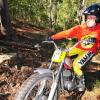Maybe there were more than one 348 exhaust pipe design. With mine it would be extremely hard, maybe impossible to get the cap off if the plug was in the central hole and it was a standard height plug.
I see in the brochure photo, the plug is in the central hole but also in the brochure photo showing the left side of the bike, the exhaust looks different to mine where it goes over the head, maybe a smaller diameter pipe. I'll have a better look at mine on the weekend and try and work out if it is different to the pipe in the brochure photo.


